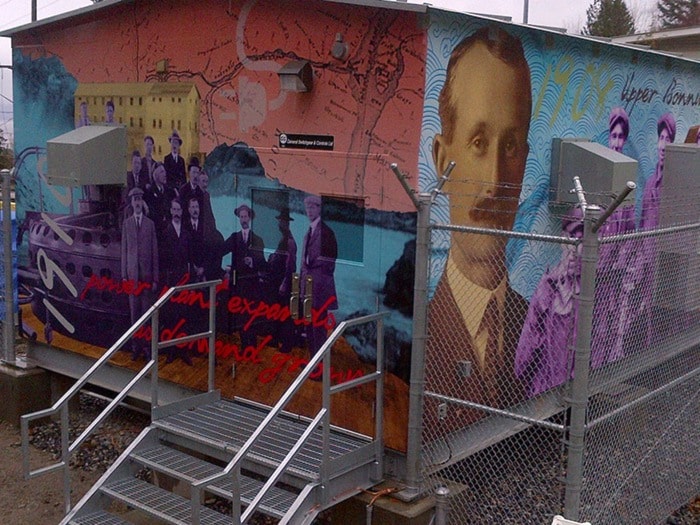Installation of a massive graphic mural wrapped up in November on a new substation erected by Nelson Hydro.
Designed, printed and installed by Nelson’s Speedpro Signs, the substation is the largest project the company has ever tackled — at more than 800 square feet of surface area.
“When Hydro originally consulted us, they were thinking of making the sub station blend into the scenery,” recalled Speedpro owner Murray Kimber.
“Given how the station is situated on the site that proved not to be viable. Rather than making it disappear I felt it was a great opportunity to make it jump out at the viewer.”
Building on the recent series of transformer wraps on either side of Baker Street, Nelson Hydro decided to tell more of its own story. Unique for having its own electrical utility, Nelson’s foray into power generation began as The Nelson Electric Light Company in 1896.
John Houston, who features large on one side of the mural, was Nelson Electric’s first chairman and eventually served as the city’s first mayor. Power was initially generated from Cottonwood Falls but within a few years, growing electrical demand compelled Houston to select Upper Bonnington Falls as a the site for a new generating station.
Kimber and his team worked with existing historical photos to put together a narrative of Hydro’s early rapid expansion. By the time a design was completed, however, the weather was beginning to turn cold.
“We found ourselves in the situation of being near minimum temperatures for working with adhesive vinyl and without the option of completing this project in the spring,” Kimber explains. “Forward was the only way to go.”
Speedpro quickly sourced a printable vinyl better suited to single digit temperatures and restricted install times to afternoons only. They draped tarps over the 45-foot-long station to keep out the rain, and used a diesel powered heater to pump warm air into the work space.
With a crew of three installers, the work on site was completed in six days.
Kimber feels Hydro and the Cultural Development Commission deserve credit for their vision.
“Utility structures in many communities are now being treated as design spaces. They are opportunities to enrich and humanize the surrounding area rather than detract from it. Nelson Hydro has been very active in promoting this philosophy.”
